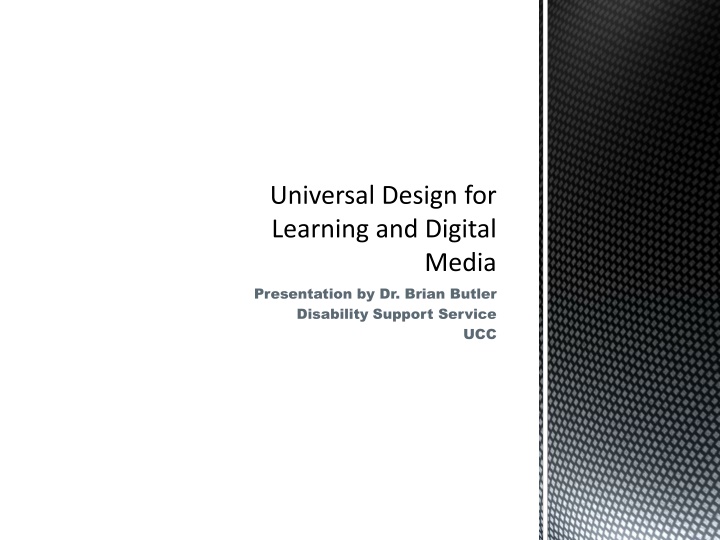
Universal Design for Learning
Explore the concept of Universal Design and its application in creating inclusive educational environments. Learn about the principles, aims, and benefits of Universal Design for Learning, which aims to provide equal learning opportunities for all individuals through flexible instructional methods and materials.
Download Presentation

Please find below an Image/Link to download the presentation.
The content on the website is provided AS IS for your information and personal use only. It may not be sold, licensed, or shared on other websites without obtaining consent from the author. If you encounter any issues during the download, it is possible that the publisher has removed the file from their server.
You are allowed to download the files provided on this website for personal or commercial use, subject to the condition that they are used lawfully. All files are the property of their respective owners.
The content on the website is provided AS IS for your information and personal use only. It may not be sold, licensed, or shared on other websites without obtaining consent from the author.
E N D
Presentation Transcript
Universal Design for Learning and Digital Media Presentation by Dr. Brian Butler Disability Support Service UCC
What is Universal Design? Universal Design is design for all. School of Design North Carolina State University www.design.ncsu.edu/cud/
Under the Disability Act 2005 the National Disability Authority in Ireland was commissioned to set in place the Centre for Excellence in Universal Design (CEUD) www.universaldesign.ie
Aims of CEUD are to promote the principles of UD in architecture, environmental design and product design
Principles of Universal Design 1 Equitable use For people with diverse abilities 2 Flexibility in use Accommodates a wide range of individual preferences and abilities 3 Simple and intuitive use - Use of the design is easy to understand regardless of the users experience, knowledge, language skills or current concentration level
4 Perceptible information The design communicates necessary information effectively to the user regardless of ambient conditions or the user s sensory abilities 5 Tolerance for error - The design minimizes hazards and the adverse consequences of accidental or unintended actions 6 Low physical effort The design can be used efficiently and comfortably and with a minimum of fatigue 7 Size and space for approach and use Appropriate size and space is provided for approach, reach, manipulation and use regardless of user s body size, posture or mobility
What is Universal Design for Learning? It is a set of principles for curriculum development that give all individuals equal opportunity to learn
What is Universal Design for Learning? It provides a blueprint for creating instructional: Goals Methods Materials Assessments
CAST and the Work of Anne Meyer and David Rose CAST have drawn up 3 principles of Universal Design for Learning and these reflect the basic neurology of the learning brain: Recognition networks Strategic networks Effective networks www.cast.org
3 Principles of Universal Design for Learning (UDL) Multiple forms of Representation Multiple forms of Expression Multiple forms of Engagement (For guidelines see www.udlcenter.org)
What negative factors can impact on learning? Being in an unfamiliar culture Having major life commitments outside academic life Stress or anxiety disorders Physical conditions that cause mobility impairment. Sensory conditions such as hearing or seeing Specific learning difficulty. Such as dyslexia or dyscalculia
What does Universal Design for Learning Achieve? Universal thinking considers the potential needs of all learners It identifies and eliminates barriers to teaching and learning It maximizes learning for learners of all backgrounds and learner preferences while minimizing the need for special accommodations
What else does Universal Design for Learning Address? UDL offers strategies that remove barriers to learning It provides flexibility to enable students to access learning in ways that make sense for them It helps address legislation Helps address changing demographics Makes optimum use of developing technologies in education
Importance of Technology to Universal Design for Learning Course web site can be vital for providing variety in instruction and materials: Syllabus of course or program of study Assignments Discussion groups Class projects Class notes
Video material Podcasts PowerPoint slides for lectures Reading material Links to other websites can also help provide additional representations of a topic
Flexibility of digital media: Text can be presented in: Any size As speech In the context of a concept map In Braille
Ensure all digital media passes accessibility guidelines Using alt-text for graphical images is important See: Royal National Institute for the Blind www.rnib.org.uk/professionals/web- accessibility World Wide Web Consortium www.w3.com
Tools for Checking Accessibility of Websites www.w3.org/wai/er/tools/ Other important resource Information available on how to create accessible: Word documents, PDF documents, PowerPoint presentations E-mails www.ucc.ie/en/teachlearn/resources/ Also see www.universaldesign.ie/newsandevents/pres entationsun
